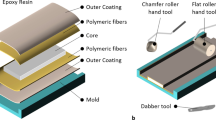Abstract
Due to the outstanding material properties the use of carbon fiber reinforced plastics in aerospace applications has grown rapidly during the last years. However, the manual process of creating a preform out of dry cut-outs is still very time-consuming and error-prone and thus limits an efficient use of this technology. Especially the high diversity of variants, the material properties and the complexity of the process limited an automation of the preforming process so far. In this paper an automation system is presented, which consists of a robot-based preforming end-effector and its offline path-planning. The end-effector has a highly modular and flexible design and integrates the three essential functions of the preforming process: gripping, draping and heating. Based on a detailed analysis of the geometric parameters of the preforms and its layers the task-specific layout of the end-effector is conducted. To achieve a preform in high-quality a solution for controlling the end-effector and planning the robot-path is necessary. Hence, a semi-automatic approach is developed, which incorporates the know-how of experts and automatically generates layup-curves with path-synchronous trigger signals for the end-effector. In an experimental set up the feasibility and flexibility of the automation solution could be successfully tested. The evaluation on three industrial moulds showed that the challenging requirements and the high quality standards could be met.











Similar content being viewed by others
References
Drechsler K (2008) Automatisierung als Schlüssel für die kostengünstige Fertigung von Faserverbund-Leichtbaustrukturen im Flugzeug- und Automobilbau (Automatica 2008). München
Wiedemann M (2009) Status of application in airframe structures and future development process. In: National Agency for Finite Element Methods and Standards (Hrsg.): The analysis advantage: perspectives on engineering simulation for today and beyond. Glasgow: NAFEMS 2009. ISBN: 978-1-87437-642-2
Frauenhofer M, Dilger K, Böhm S, Ströhlein T (2007) Potentiale des induktiven Preformens. ifs-Kolloquium, Braunschweig
Schuh G, Aghassi S, Orilski S, Schubert J, Bambach M, Freudenberg R, Hinke C, Schiffer M (2011) Technology roadmapping for the production in high-wage countries. Prod Eng 5:463–473
Lien TK, Davis PG (2008) A novel gripper for limb materials based on lateral Coanda ejectors. Ann CIRP 57:33–36
Saadat M, Nan P (2002) Industrial applications of automatic manipulation of flexible materials. Ind Robot Int J 29(5):434–443
Seliger G, Szimmat F, Niemeier J, Stephan J (2003) Automated handling of non-rigid parts. Ann CIRP 52(1):21–24
Seliger G, Gutsche C, Hsieh L-H (1992) Process planning and robotic assembly system design for technical textile fabrics. Ann CIRP 41(1):33–36
Stephan J (2001) Beitrag zum Greifen von Textilien. IPK, Berlin. ISBN 3-8167-5622-0
Großmann K, Mühl A, Löser M, Cherif C, Hoffmann G, Torun A (2010) New solutions for the manufacturing of spacer preforms for thermoplastic textile-reinforced lightweight structures. Prod Eng 4:589–597
Kordi MT, Hüsing M, Corves B (2007) Development of a multifunctional robot end-effector system for automated manufacture of textile preforms. (Hrsg.): IEEE/Asme international conference on advanced intelligent mechatronics: IEEE 2008. ISBN: 978-1-4244-1263-1
Mills A (2001) Automation of carbon fibre preform manufacture for affordable aerospace applications. Compos A Appl Sci Manuf 32(7):955–962
Götz R (1991) Strukturierte Planung flexibel automatisierter Montagesysteme für flächige Bauteile (Techn. Univ., Diss.–München, 1991). Berlin: Springer 1991. ISBN: 3-540-54401-1
Reinhart G, Straßer G (2011) Flexible gripping technology for the automated hand-ling of limp technical textiles in composites industry. Prod Eng 5:301–306
Failli F, Dini G (2004) An innovative approach to the automated stacking and grasping of leather plies. Ann CIRP 53(1):31–34
Schutzrecht DE 20 2009 014 155.1 (2010). IMA Ingenieurbüro Anton Abele + Partner GmbH; Technische Universität München. Pr.: 19.10.2009. Ehinger, C.; Haas, B.; Scharrer, J.; Straßer, G.: Vorrichtung zum Legen von flachen Bauteilen, insbesondere von formlabilen Bauteilen, auf ein Formwerkzeug
Reinhart G, Ehinger C (2011) Novel robot-based end-effector design for an automated preforming of limb carbon fiber textiles. In: Schuh G et al. (Hrsg.): Future trends in production engineering: Proceedings of the first conference of the german academic society for production engineering (WGP), Berlin, Germany, 8th-9th June 2011. ISBN: 978-3-642-24490-2
Angerer A, Ehinger C, Hoffmann A, Reif W, Reinhart G (2011) Design of an automation system for preforming processes in aerospace industries. In: Wang MY (Hrsg.): IEEE international conference on automation science and engineering (CASE 2011) Piscataway, NJ: IEEE 2011, p. 557-562. ISBN: 978-1-4577-1730-7
Meyer O (2008) Kurzfaser-Preform-Technologie zur kraftflussgerechten Herstellung von Faserverbundbauteilen. <http://d-nb.info/988375435>. Stuttgart: 2008
Greb C, Schnabel A, Gries T, Kruse F (2010) Development of new preforming processes for high performance fibre-reinforced plastic (FRP) components. Sampe J 5:42–51
Brecher C, Emonts M (2011) Automatisierte Handhabung für die FVK-Großserienproduktion. In: 17. Nationales Symposium SAMPE Deutschland e. V. (Hrsg.): Faserverbundwerkstoffe 2011
Köhler G, Ochs A, Schneider M (2009) Automatisierung in der Leichtbauproduktion. wt Werkstattstechnik online 99(9):614–617
Acknowledgments
This paper presents the results of the conjoined research project CFK-Tex, which was funded by the European Union and the Free State of Bavaria within the program for micro-systems technology. Besides the research institutions iwb Application Center (Technische Universität München) and ISSE (Universität Augsburg) the following companies supported the research activities: Premium Aerotec GmbH, eurocopter Germany GmbH, KUKA Roboter GmbH, IMA A. Abele+Partner GmbH and TopCut-Bullmer GmbH.
Author information
Authors and Affiliations
Corresponding author
Rights and permissions
About this article
Cite this article
Ehinger, C., Reinhart, G. Robot-based automation system for the flexible preforming of single-layer cut-outs in composite industry. Prod. Eng. Res. Devel. 8, 559–565 (2014). https://doi.org/10.1007/s11740-014-0546-y
Received:
Accepted:
Published:
Issue Date:
DOI: https://doi.org/10.1007/s11740-014-0546-y




